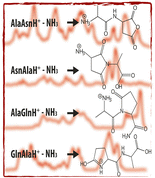Deamidation Reactions of Asparagine- and Glutamine-Containing Dipeptides Investigated by Ion Spectroscopy |
| |
| Authors: | Lisanne J M Kempkes Jonathan Martens Josipa Grzetic Giel Berden Jos Oomens |
| |
| Institution: | 1.FELIX Laboratory, Institute for Molecules and Materials,Radboud University,Nijmegen,The Netherlands;2.Van ‘t Hoff Institute for Molecular Sciences,University of Amsterdam,Amsterdam,The Netherlands |
| |
| Abstract: | Deamidation is a major fragmentation channel upon activation by collision induced dissociation (CID) for protonated peptides containing glutamine (Gln) and asparagine (Asn) residues. Here, we investigate these NH3-loss reactions for four Asn- and Gln-containing protonated peptides in terms of the resulting product ion structures using infrared ion spectroscopy with the free electron laser FELIX. The influence of the side chain length (Asn versus Gln) and of the amino acid sequence on the deamidation reaction has been examined. Molecular structures for the product ions are determined by comparison of experimental IR spectra with spectra predicted by density functional theory (DFT). The reaction mechanisms identified for the four dipeptides AlaAsn, AsnAla, AlaGln, and GlnAla are not the same. For all four dipeptides, primary deamidation takes place from the amide side chain (and not from the N-terminus) and, in most cases, resembles the mechanisms previously identified for the protonated amino acids asparagine and glutamine. Secondary fragmentation reactions of the deamidation products have also been characterized and provide further insight in – and confirmation of – the identified mechanisms. Overall, this study provides a comprehensive molecular structure map of the deamidation chemistry of this series of dipeptides. |
| |
| Keywords: | |
| 本文献已被 SpringerLink 等数据库收录! |
|

